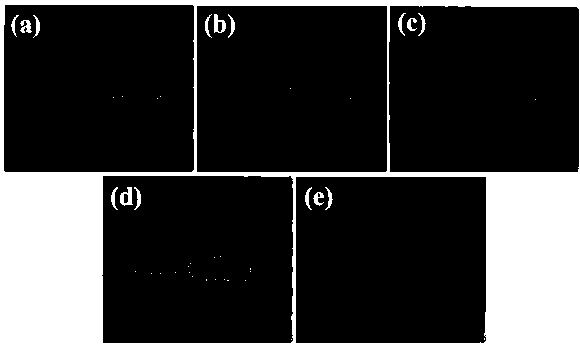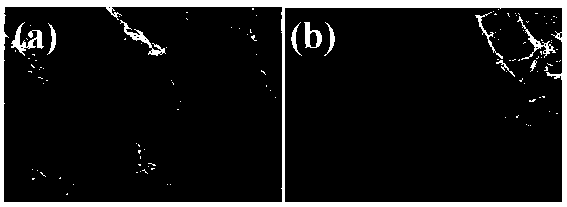Nano-scale electrochemically expanded graphite paper conductive substrate and preparation method thereof
A technology of expanded graphite and conductive matrix, applied in the field of materials, can solve problems such as complex preparation conditions, and achieve the effects of simple preparation method, reduced capacitance loss and low production cost
- Summary
- Abstract
- Description
- Claims
- Application Information
AI Technical Summary
Problems solved by technology
Method used
Image
Examples
Embodiment 1
[0035] Example 1: NiCo-LDH@EGP prepared according to the method of the present invention
[0036] Take two pieces of graphite paper and cut them to a size of 1 cm × 3 cm × 1 mm, ultrasonically clean them with ethanol for 5 min, and then dry them at 80°C; dissolve 150 mg of TBA in 30 ml of acetonitrile solution and stir to dissolve; Clamp two pieces of GP with electrode clamps, align them and insert them into the above mixture; the voltage between the two electrodes is controlled at 10 V, and the electrochemical intercalation expands for 15 minutes. The graphite paper expanded by electrochemical intercalation was freeze-dried at minus 50°C for 12 hours to obtain a conductive matrix material (EGP). Weigh 146 mg Ni(NO 3 ) 2 ∙6H 2 O, 292 mg Co(NO 3 ) 2 ∙6H 2 O, 120 mg urea, and dissolved in 30 ml deionized water, stirred for 10 min, until fully dissolved. Add freeze-dried EGP and let stand for 30 min. The solution was then poured into a 50 ml reaction kettle. Incubate at ...
Embodiment 2
[0038] Example 2: NiCo-LDH@EGP-2 prepared according to the method of the present invention
[0039] Take two pieces of graphite paper and cut them to a size of 1 cm × 3 cm × 1 mm, ultrasonically clean them with ethanol for 5 min, and then dry them at 80°C; dissolve 150 mg of TPA in 30 ml of acetonitrile solution and stir to dissolve; Clamp two pieces of GP with electrode clamps, align them and insert them into the above mixture; the voltage between the two electrodes is controlled at 10 V, and the electrochemical intercalation expands for 15 minutes. The graphite paper expanded by electrochemical intercalation was freeze-dried at minus 50°C for 12 hours to obtain a conductive matrix material (EGP). Weigh 146 mg Ni(NO 3 ) 2 ∙6H 2 O, 292 mg Co(NO 3 ) 2 ∙6H 2 O, 120 mg urea, and dissolved in 30 ml deionized water, stirred for 10 min, until fully dissolved. Add freeze-dried EGP and let stand for 30 min. The solution was then poured into a 50 ml reaction kettle. Incubate a...
Embodiment 3
[0041] Example 3: NiCo-LDH@EGP-3 prepared according to the method of the present invention
[0042] Take two pieces of graphite paper and cut them to a size of 1 cm × 3 cm × 1 mm, ultrasonically clean them with ethanol for 5 min, and then dry them at 80°C; dissolve 150 mg of THA in 30 ml of acetonitrile solution and stir to dissolve; Clamp two pieces of GP with electrode clamps, align them and insert them into the above mixture; the voltage between the two electrodes is controlled at 10 V, and the electrochemical intercalation expands for 15 minutes. The graphite paper expanded by electrochemical intercalation was freeze-dried at minus 50°C for 12 hours to obtain a conductive matrix material (EGP). Weigh 146 mg Ni(NO 3 ) 2 ∙6H 2 O, 292 mg Co(NO 3 ) 2 ∙6H 2 O, 120 mg urea, and dissolved in 30 ml deionized water, stirred for 10 min, until fully dissolved. Add freeze-dried EGP and let stand for 30 min. The solution was then poured into a 50 ml reaction kettle. Incubate a...
PUM
| Property | Measurement | Unit |
|---|---|---|
| Current density | aaaaa | aaaaa |
Abstract
Description
Claims
Application Information
 Login to View More
Login to View More - R&D
- Intellectual Property
- Life Sciences
- Materials
- Tech Scout
- Unparalleled Data Quality
- Higher Quality Content
- 60% Fewer Hallucinations
Browse by: Latest US Patents, China's latest patents, Technical Efficacy Thesaurus, Application Domain, Technology Topic, Popular Technical Reports.
© 2025 PatSnap. All rights reserved.Legal|Privacy policy|Modern Slavery Act Transparency Statement|Sitemap|About US| Contact US: help@patsnap.com



